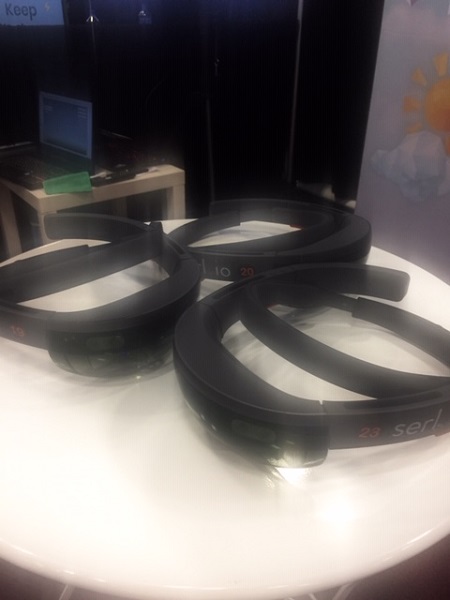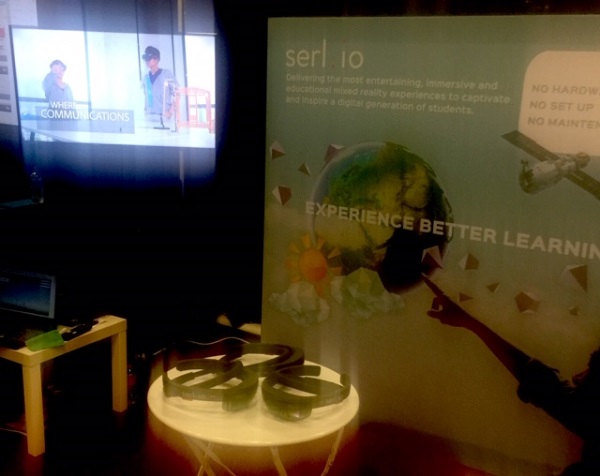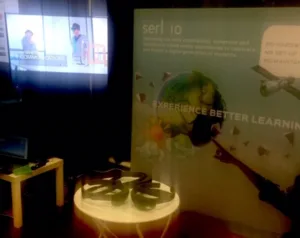TCEA 2019, one of the largest educational technology conferences in the U.S., convened in San Antonio earlier this year and offered up some saporous (tasty – ed.) surprises. Ed-tech conferences in this day and age usually offer minimal refection, dishing up the same themes and products year over year. Every so often, however, we find a delightful flavor that truly soothes the persistently hungry palate of the ed-tech gourmand.

One toothsome MR product, aimed directly at the ed market, caught my liking at TCEA this year: Serl.io.
![]() According to CEO Terence Loo, Serl.io is a company “setting out to make MR work for schools.” With offices in Singapore and Houston, Serl.io is currently focused on reaching the Singapore education system. Their product launch customer/school involved Crescent Girls’ School last month, and they are now rolling out MR to other schools in Singapore. Partnerships and field testing opportunities were pursued here in the States with the likes of San Jacinto College and the University of Houston. Below find two videos highlighting the use of Serl.io, first in education and second in an industry setting.
According to CEO Terence Loo, Serl.io is a company “setting out to make MR work for schools.” With offices in Singapore and Houston, Serl.io is currently focused on reaching the Singapore education system. Their product launch customer/school involved Crescent Girls’ School last month, and they are now rolling out MR to other schools in Singapore. Partnerships and field testing opportunities were pursued here in the States with the likes of San Jacinto College and the University of Houston. Below find two videos highlighting the use of Serl.io, first in education and second in an industry setting.
I was drawn to Serl.io’s mixed reality solution, because it seems to offer what educators want most in a tasty and educationally nutritional experience. Let’s back up for a minute and explain what I mean. The problem with most MR ‘tastings’ in K-20 classrooms today is that these experiences don’t really take into consideration how schools really work. And for that reason, mixed reality occupies a position of hyper-optionality and a negligible footprint in schools.
Educators often tender acidified complaints about the current state of mixed reality. Some of the most common indictments include:
“I can only have one student at a time enjoy the MR experience.”
“It is difficult to manage all the pieces and processes of viewing MR in the classroom.”
”Most MR experiences are vacuous micro-experiences; these short visual excursions are not able to fill up an entire class session with thoughtful and substantive learning activity.”
“There’s not much truly transformative content and very little curricular reach.”
“Most MR content is observational or informational, aimed at the low-lying fruit of engagement or retention.”
If making “MR work for schools” is the goal, as Loo suggests, then Serl.io must address these concerns head on. And so it does. Here’s how:
Towards Social MR
While typical AR experiences center mostly on the use of a mobile device and are usually restricted to a single student activity for visual engagement, Loo counters: “Our MR sessions are thirty minutes and we run up to 18-20 students simultaneously in that time slot. They are broken into 3 or 4 students per station during the session, where they collaboratively work through the MR activity. “
 Serl.io is a MicroSoft HoloLens developer
Serl.io is a MicroSoft HoloLens developer
Towards Scaling
Serl.io offers what they call “class-scale mixed reality”, that is to say, a solution designed to work in a ‘real’ classroom, not just an exhibitor’s booth. Loo expands the definition of scaling by adding: “affordability and scalability to the logistical concerns in the use of MR”. This notion includes management, reporting, and of the flexibility of the classroom MR experience.
Serl.io offers an MR Console, which can manage the MR stations and sessions. This is a windows app that can run on 10 laptops/tablets simultaneously, allowing teachers to monitor each station without the need to be on-device. According to Loo, “teachers can see what the students are seeing and how they are interacting with each simulation; can control the scene/pace/progression of the learning experience; can monitor headset power status; and can ensure that the students are synched and in-app during the learning simulation.” The teacher can also use the console to produce assessment reports and session logs. Loo provides the following example:
“In Ecolysis, our biology title, students will generate a report of the field samples and analysis that they conduct in the MR session; they take [this data] back to class to report out and discuss as an in-class close out activity. The report will specify the MR session ID, students in the group and the samples and analysis each of the students collected.” Loo adds: “We also collect analytics such as positional heat maps, gaze time/location , and interactions. These are being captured as user/student engagement data that we are using in the future to integrate more contextual MR experiences (through AI)”.
 Serl.io at TCEA 2019
Serl.io at TCEA 2019
Towards Richer and Deeper Learning
Serl.io content is appetizing by design: it offers rich game-based simulations, cooperative learning schemes, and the situational flexibility of self-led, team-led, or teacher led MR experiences. Some of the rich Serl.io educational simulations can be viewed with this link. According to CEO Terence Loo, “We continue working with schools and teachers to establish content by educators, for educators.” This type of mixed reality is a mouth-watering encounter. Num num num. –Len Scrogan

